United Parcel Service Is A Buy Now
Summary
- United Parcel Service reported second quarter results and revenue and earnings per share disappointed investors.
- The company is currently paying a dividend yield of 5%, the highest in its history.
- We can assume that UPS is continuing to grow at a solid pace in the next few years - in its core markets as well as the healthcare logistics market.
- The stock is trading below its intrinsic value and is a "Buy" at this point.
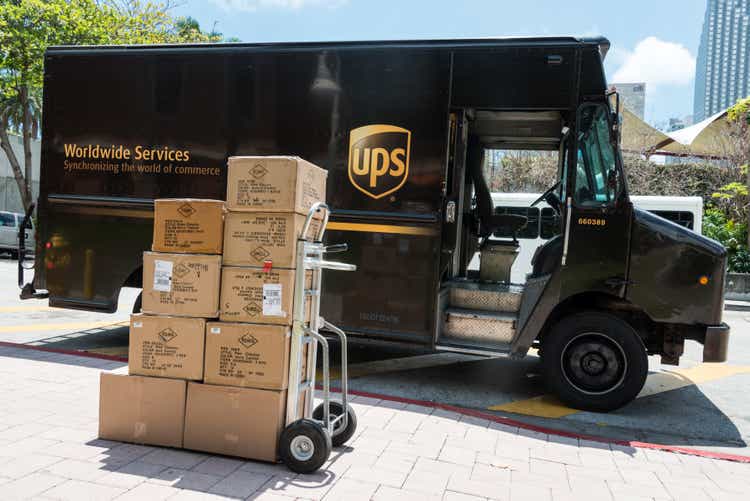
Juanmonino
In my last few articles about United Parcel Service (NYSE:UPS) I have always been rather cautious about the business, and I rated UPS as a "Hold" in all my articles - including my last article published in April 2023. In my last article, I already indicated that UPS is getting closer to a point where the stock could be bought. And as the stock continued to decline in the last few quarters, it makes sense to take another (and closer) look at UPS and ask the question if United Parcel Service could be a good investment and "Buy" now.
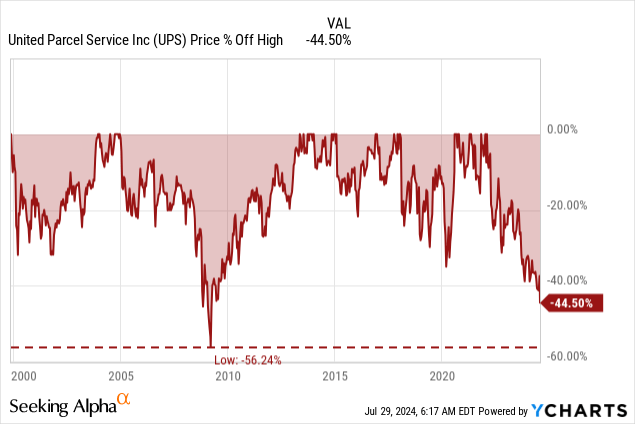 Data by YCharts
Data by YCharts
So far, the stock declined already 45% from its previous all-time high and the decline is almost as steep as during the Great Financial Crisis and this certainly makes UPS look like a buying opportunity. However, only looking at the stock price is certainly not enough for a good investment decision.
Disappointing Quarterly Results
We start by looking at the last quarterly results and with earnings per share as well as revenue missing estimates, it was rather a disappointment for investors and analysts. By the way, FedEx Corporation (FDX) was beating EPS and revenue estimates. And the stock performance of UPS, as well as FedEx, also seems to reflect the sentiment surrounding the two companies (and stocks) - while FedEx increasing in value (similar to the overall market), UPS declined.
 Data by YCharts
Data by YCharts
Revenue for UPS declined from $22,055 million in Q2/23 to $21,818 million in Q2/24 - resulting in a 1.1% year-over-year decline. Operating income also declined 32.6% YoY from $2,985 million in the same quarter last year to $2,011 million this quarter. And finally, diluted earnings per share declined from $2.42 in Q2/23 to $1.65 in Q2/24 resulting in a 31.8% year-over-year bottom line decline. Adjusted diluted earnings per share also declined from $2.54 in the same quarter last year to $1.79 this quarter.
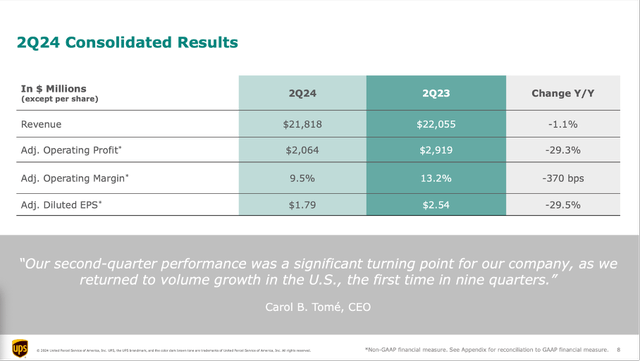
UPS Q2/24 Presentation
Dividend
At this point, UPS is also interesting for its dividend yield. With a dividend yield above 5%, UPS is paying the highest dividend yield in its history right now. UPS is paying a quarterly dividend of $1.63 resulting in an annual dividend of $6.52 and the company is constantly increasing its dividend from year to year, but the last dividend increase was only one cent.
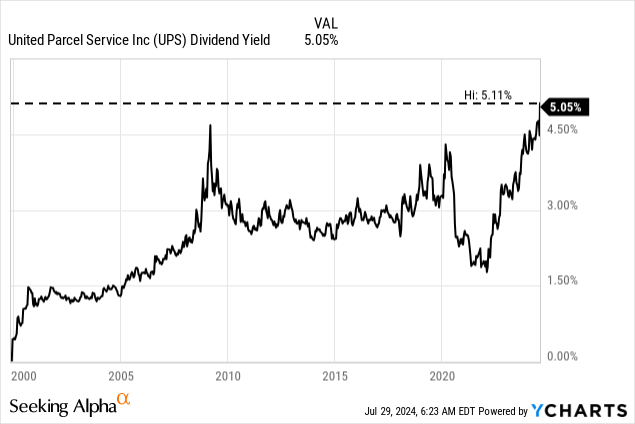 Data by YCharts
Data by YCharts
And at first impulse, a high dividend yield seems good for investors and a stock with a high dividend yield seems like a good investment, but we have to take a second closer look. A high dividend yield can also be a warning sign for a business that is in trouble. A high dividend yield can be the result of a still high dividend (as many businesses are trying to keep the dividend at a high level as long as possible) and an already declining stock price due to a struggling business.
However, we must be cautious about the dividend right now as payout ratios are extremely high. When comparing the annual dividend payments of $6.52 to earnings per share of $6.13 in the last four quarters, we get a payout ratio above 100% which is never a good sign. When comparing $5.4 billion in dividend payments the company has to make in fiscal 2024 to an expected free cash flow of $5.8 billion, we still get a payout ratio of 93% (which is acceptable for one or two years, but too high for a constant payout ratio).
Growth
When talking about dividend safety, one aspect is extremely important - the potential of a business to continue growing. As long as a business is able to increase its earnings per share and free cash flow, the probability of being able to pay a high dividend is much higher. For starters, we can look at the guidance for fiscal 2024. Management is expecting about $93 billion in revenue for fiscal 2024 and compared to about $91 billion, the top line would increase about 2% YoY. For the second half of 2024, the company is expecting the U.S. Domestic business to grow about 5.0%.
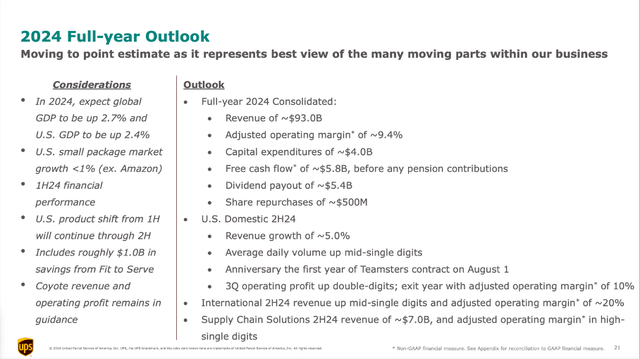
UPS Q2/24 Presentation
We should not just look at one fiscal year but at least at the mid-term future and during the 2024 Investor Day, management introduced several strategies to grow in the years to come.
One very simple way growth will re-emerge in the coming years is the return to normal occurring in the next few years. The last few years (since 2020) have rather been outliers with above-average growth in the years 2020 and 2021 and in the last two years we saw the counterreaction with lower growth rates or even a declining business. But in the following years, UPS is expecting low-to-mid-single digit growth returning to its core markets (the U.S. small package market as well as the international small package market).
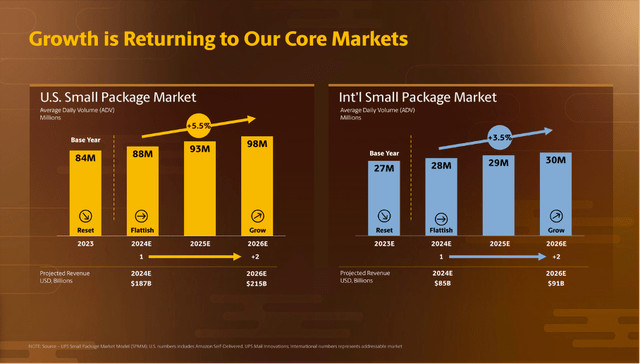
UPS 2024 Investor Day Presentation
Aside from core markets returning to growth again, UPS will also try to target growing markets in the next few years. Especially for the international package market, UPS will focus on the countries which are expected to grow with the highest pace. These are especially the Latin America market, and several countries in Asia.
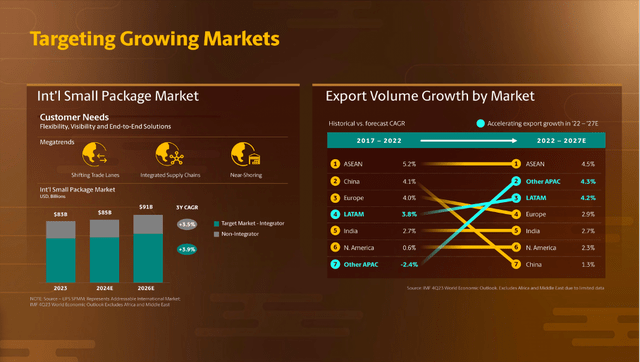
UPS 2024 Investor Day Presentation
Of course, these are all not markets growing with a high double-digit pace and will also not lead to UPS having its revenue jump again. But as we will see later, revenue growing in the low-to-mid-single digits is enough for UPS.
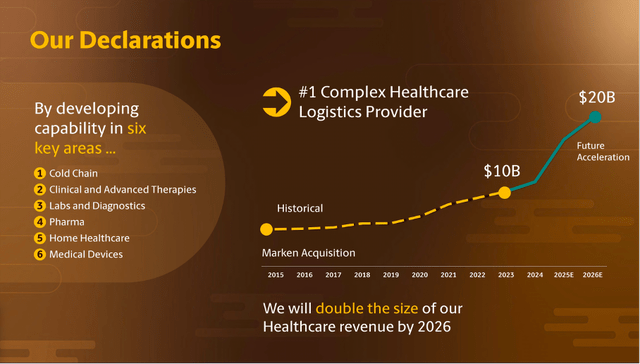
UPS 2024 Investor Day Presentation
Another growth market the company is focusing on is the healthcare logistics market. Healthcare revenue was already $10 billion in 2023 and in the next few years, management is expecting revenue growth to accelerate with healthcare revenue being about $20 billion in fiscal 2026. During the last earnings call, management commented on the progress of the healthcare logistics business:
In healthcare we just opened our first dedicated healthcare facility in Dublin, Ireland. This 82,000 square foot facility provides storage and fulfillment for a range of complex pharmaceutical and healthcare products. And in the Netherlands, we increased the size of our flagship facility in Roermond to now more than 235,000 square feet, including expanded ultra-cold storage capabilities to support the growing market of complex biopharma products.
The healthcare logistics market is often described as complex and difficult, but it is not only a huge market - according to estimates the entire healthcare logistics market is $152 billion - but is also offering potentially high margins for the companies operating in it.
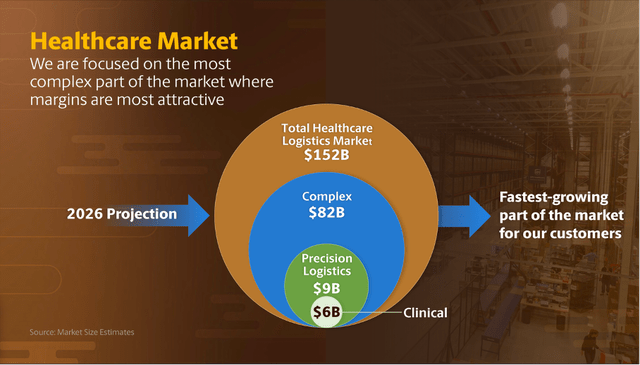
UPS 2024 Investor Day Presentation
And combining all these growth initiatives, UPS is expecting revenue to be about $114 billion in fiscal 2026. About $6 billion will be due to inorganic growth and the biggest part - about $10 billion - will stem from the U.S. domestic market (including SMB growth and UPS growing select enterprise customers).
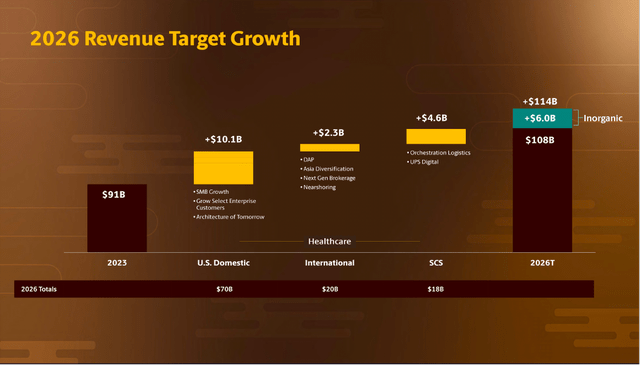
UPS 2024 Investor Day Presentation
Additionally, UPS was buying back shares constantly in the last 25 years. And we can assume that UPS will continue to do so and probably with a similar pace as in the past, which will add about 1.5% growth to the bottom line. Between 2000 and 2024, the number of outstanding shares decreased with a CAGR of 1.58%. For fiscal 2024, the company will spend only about $500 million on share buybacks, which is enough to repurchase only about 0.5% of the outstanding shares.
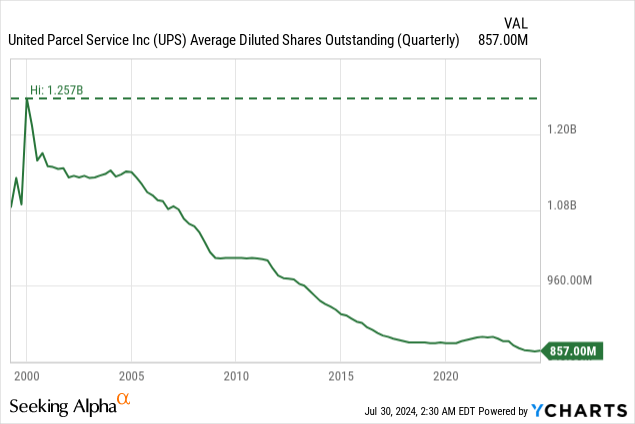 Data by YCharts
Data by YCharts
Intrinsic Value Calculation
When looking at the simple valuation multiples, the stock does not look so cheap. At the time of writing, UPS is trading for 21 times earnings as well as 24 times free cash flow. And while these valuation multiples are not extremely expensive, they are also not implying that we are dealing with a bargain.
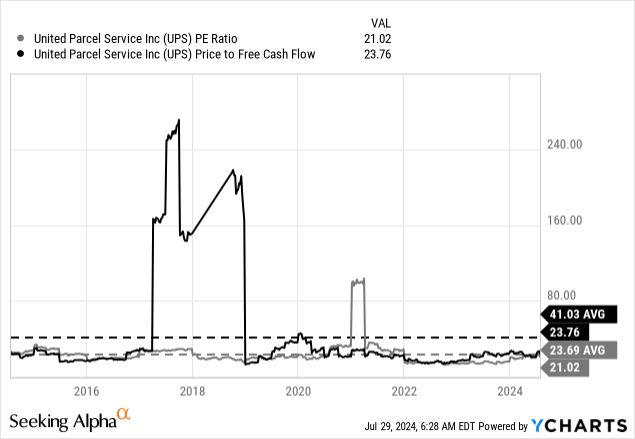 Data by YCharts
Data by YCharts
Instead of using simple valuation multiples, we can rather determine an intrinsic value by using a discount cash flow calculation. As always, we are calculating with a 10% discount rate (as this is the return we are expecting to achieve at least) and we are using the last reported number of outstanding shares (857 million).
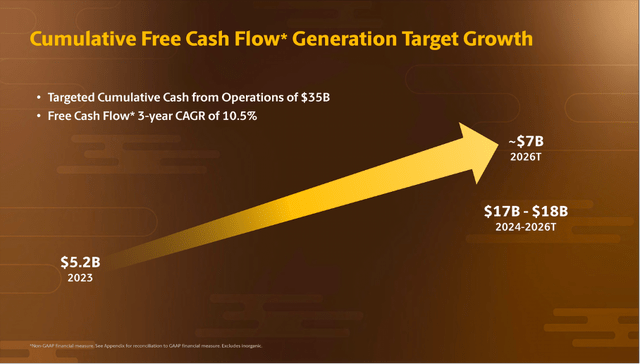
UPS 2024 Investor Day Presentation
Now we must make some estimates for free cash flow and growth rates in the years to come. Free cash flow in the last four quarters was $4,647 million and according to the company's guidance for fiscal 2024 we can expect about $5.8 billion but not including pension contributions. But let's be cautious and assume $5 billion in fiscal 2024 and $6 billion in fiscal 2025. In fiscal 2026, the company is expecting about $7 billion in free cash flow, and this will add up to $18 billion according to the company's projections. Following 2026, we assume about 5% growth until perpetuity. This would also be in line with earning per share growth of 5.40% in the last ten years.
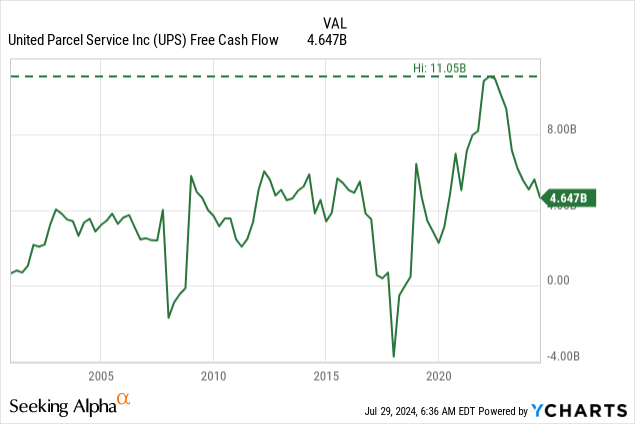 Data by YCharts
Data by YCharts
When calculating with these assumptions, we get an intrinsic value of $146.10 for UPS. And the stock can be seen as slightly undervalued at this point and can be rated as a "Buy".
Technical Picture
Additionally, we can look at the technical picture. When looking at the chart, we could make the argument to wait a little bit longer and maybe the stock might decline about $10 or $15 lower. In the range between $110 and $120 we find a very strong support level. At around $110 we currently have the 200-month simple moving average as well as a strong support line connecting the lows of the Great Financial Crisis as well as the COVID-19 lows of 2020 (green line).
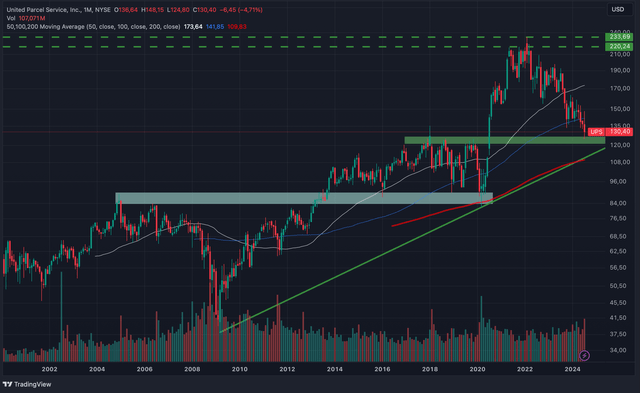
UPS Monthly Chart (TradingView)
And a little higher, around $120 we find the highs of the years 2017 until 2020, which were a strong resistance level back then and can now be seen as a strong support level for the stock (green area).
Conclusion
For the first time in several years, I would see UPS as a "Buy" and the stock is now trading below its intrinsic value. However, we might wait a little longer and buy the stock in the range between $110 and $120 where we find several strong support levels. We can assume that UPS will continue to grow with a solid pace in the mid-single digits in the years to come and with a dividend yield of 5% the stock can be interesting for investors.
Disclaimer: Investing carries risk. This is not financial advice. The above content should not be regarded as an offer, recommendation, or solicitation on acquiring or disposing of any financial products, any associated discussions, comments, or posts by author or other users should not be considered as such either. It is solely for general information purpose only, which does not consider your own investment objectives, financial situations or needs. TTM assumes no responsibility or warranty for the accuracy and completeness of the information, investors should do their own research and may seek professional advice before investing.

